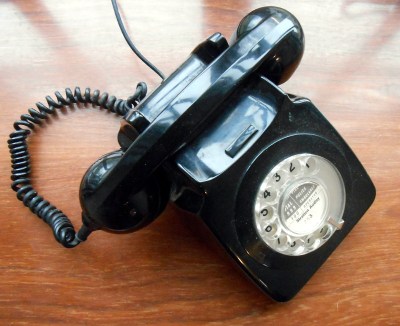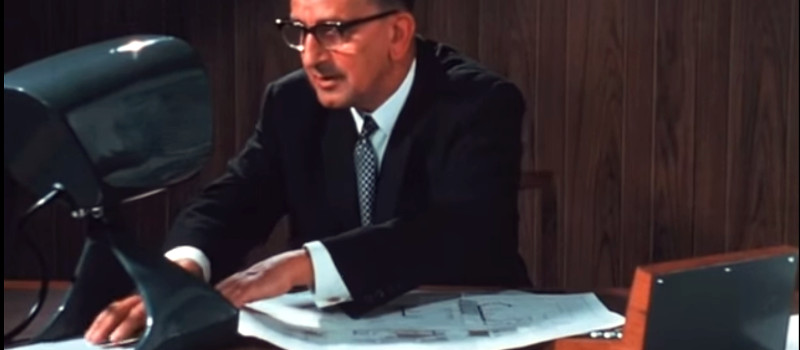One of the most famous lectures in the history of technology was delivered by [Douglas Engelbart] in December 1968, at a San Francisco conference. In it he described for the first time most of what we take for granted in our desktop computers and networking today, several years before even the first microprocessor made it to market. It is revered not only because it was the first airing of these ideas, but because it was the event that inspired and influenced many of those who developed them and brought them to market. You may have heard of it by its poplar name: the Mother of All Demos.
This was an exciting time to be a technologist, as it must have been obvious that we lay on the brink of an age of ubiquitous computing. [Engelbart] was by no means alone in looking to the future and trying to imagine the impact that the new developments would have in the decades to come. On the other side of the Atlantic, at the British Post Office Telephone research centre at Dollis Hill, London, his British counterparts were no less active with their crystal ball gazing. In 1969 they produced our film for today, entitled complete with misplaced apostrophe “Telecommunications Services For The 1990’s” , and for our 2017 viewpoint it provides a quaint but fascinating glimpse of what almost might have been.

Until the 1980s, the vast majority of British telephone services were a tightly regulated state monopoly run as part of the Post Office. There were only a few models of telephone available in the GPO catalogue, all of which were fixed installations with none of the phone sockets we take for granted today. Accessories such as autodiallers or answering machines were eye-wateringly expensive luxuries you’d only have found in offices, and since the fax machine was unheard of the height of data transfer technology was the telex. Thus in what later generations would call consumer information technology there really was only one player, so when they made pronouncements on the future they were a good indication of what you were likely to see in your home.
The film starts with a couple having a conversation, she in her bedroom and he in a phone box. Forgotten little touches such as a queue for a phone box or the then-cutting-edge-design Trimphone she’s using evoke the era, and the conversation leaves us hanging with the promise that their conversation would be better with video. After the intro sequence we dive straight into how the GPO thought their future network would look, a co-axial backbone with local circuits as a ring.
The real future-gazing starts with an office phone call to an Australian, at which we’re introduced to their concept of video calling with a colour CRT in a plastic unit that could almost be lifted from the set of The Jetsons. The presenter then goes on to describe a mass information service which we might recognise as something like our WWW, before showing us the terminal in more detail. Alongside the screen is a mock-up of a desktop console with keypad, cassette-based answerphone recorder, and a subscriber identity card slot for billing purposes. Period touches are a brief burst of the old harsh dial tone of a Strowger exchange, and mention of a New Penny, the newly-Decimalised currency. We’re then shown the system transmitting a fax image, of which a hard copy is taken by exposing a photographic plate to the screen.
Perhaps the most interesting sequence shows their idea of how an online information system would look. Bank statements and mortgage information are retrieved, though all with the use of a numeric keypad rather than [Englebart]’s mouse. Finally we see the system being used in a home office, a situation shown as farcical because the worker is continually harassed by his children.
Scorecard

So nearly five decades later, what did they get right and how much did they miss? The area you might expect them to be most accurate is oddly the one in which they failed most. The BT telecommunications backbone is now fibre-optic, and for the vast majority of us the last mile or two is still the copper pair it would have been a hundred years ago. In terms of the services though we have all of the ones they show us even if not in the form they envisaged. Fax and answering machines were everyday items by the 1980s, and though it didn’t gain much traction at the time we had video calling as a feature of most offices by the 1990s. We might however have expected them to anticipate a fax machine with a printer, after all it was hardly new technology. Meanwhile the online service they show us is visibly an ancestor of Prestel, which they launched for the late 1970s and which failed to gain significant traction due to its expense.
Another area they miss is wireless. We briefly see a pager, but even though they had a VHF radio telephone service and the ancestors of our modern cellular services were on the drawing board on the other side of the Atlantic at the time, they completely miss a future involving mobile phones.
The full film is below the break. It’s a charming period production, and the wooden quality of the action shows us that while the GPO engineers might have been telephone experts, they certainly weren’t actors.
https://www.youtube.com/watch?v=EUcF_OuV19k
















A little more showy than the Mother of all Demos, More gimmicky. You know it’s prediction and concepts, vs an actual tech demo of world changing ideas… All in all, a good effort by the Old Dirt, but certainly no Mother of all Demos. :)
As for anyone who has NOT yet seen the Mother of all Demos… I’ve had complete NON-NERDS transfixed by it before! It’s a MUST see! I’ve personally watched it a few times in full myself!
The big deal about the Mother of all Demos is that everything he’s doing is _real_. He _is_ using a mouse-based collaborative work system 20 years before the Internet. It’s not a “the future could look like this” bit of fluff, but it’s instead a “here’s the work I’ve done”.
I love the retro-futurist stuff because of its imagination. But to compare it with an actual demo of (granted prototyping) work accomplished is confusing reality with simulation…
Exactly
The picturephone system did exist. It had the same features depicted in the article’s demo, including the downward facing camera for documents, and a terminal interface to mainframe computers. The only bit of fiction is the “printer” that works by pressing a film on the screen. The picturephone system went into commercial operation by AT&T in 1964, but it was too expensive and people just didn’t find the use for it.
https://www.youtube.com/watch?v=WzdCKBZP4Jo
I saw the film a few years afterwards (in ’71 I think) as part of the process of introducing terminals to the shop floor where at the place I was working.
“He can do all his work from the comfort of his own home”… best joke I’ve seen in ages. haha
https://youtu.be/EUcF_OuV19k?t=482
Man I love these futurist videos.
Pretty sure I pasted that video starting at 8:02 but it isn’t behaving
“You may have heard of it by its poplar name: the Mother of All Demos.”
Well one’s ROOTS had to start somewhere. ;-)
“The full film is below the break. It’s a charming period production, and the wooden quality of the action shows us that while the GPO engineers might have been telephone experts, they certainly weren’t actors.”
Bet they kind of grew on you though.
That is an awesome presentation of the then future.
The forward thinking to include the hassles the new technology would bring. The pager going off half way down the stairs, the girl in her dressing gown and curlers not wanting to be seen, the hassles of working from home.
Pure gold!
Anachronistic hilarity aside, that video is surprisingly prescient. The architecture they describe for the “phone” system is actually pretty close to what we have today for cable TV/internet hookups; they even see the possibility of microwave wireless for the last leg, though not quite the way we use it for wifi to everything. The computer services depicted actually arrived, although they are delivered over an open net architecture instead of a system designed from the ground up with every little function in mind. The video terminals are period; the “video conferencing” terminals in the movie Colossus: The Forbin Project (ca. 1974) are similarly hilarious, being mounted in desks. At the time the only known technologies for both video capture and playback involved physically deep CRT vacuum tubes. The producers would have been laughed out of the industry if they had suggested that something like a modern cellphone, with its flat display and microscopic video camera might be possible. And similarly with the UV “taking a picture” because printers were expensive and putting an image like that in digital storage would have required a personal mainframe.
It seems like they got right was that there would be fatter data pipes. What they didn’t get (as pretty much nobody did) was how massively big memory would get, and that both flat displays and sensors would emerge vastly superior to CRT’s.
they were talking about the 1990s and then, CRTs still reigned supreme.
And yet a side-scanning flat CRT display did exist by the 70’s. It was monochrome or two-color, and used in fighter jets for data display, and some oscilloscopes.
And ditto Saabman on the film’s light touch and humorous elements. Technology doesn’t solve everything — “It looks like you won’t be able to buy a house for twenty years!” And of course the final scene depicting the “joys” of working from home LOL.
Sounds like Mr. Peabody narrating!
the 90’s are going to be wild!
They will have been wild!
First thing I hacked in that alternate future, I realised I could use the terminal to expose PCB designs direct to the board. But I had to send the image to someone else and have them send it back to me. Damned lack of local storage! Couldn’t keep anything private.
Nice idea, Piecutter! Although there might be a way: I’d assume the system has a ‘preview’ function, as otherwise it’d be hard to work out whether the document is framed properly.
(Assuming the device we saw actually worked, of course, and wasn’t just a mockup. It certainly didn’t look like it was either scanning or reproducing standard document sizes, so if it’s real it probably had a way to ensure you were lining them up nicely)
Yeah, it was cheaper to manufacture with just some index marks on the base, though.
Although I did try to rewire it to loop back to the display, but I mixed up the signals for the viewer and the UV burner. My corneas were clouded for a week. Kind of hard to explain to people why the sudden “face only” tan had all those wiggly lines, too.
“The BT telecommunications backbone is now fibre-optic, and for the vast majority of us the last mile or two is still the copper pair it would have been a hundred years ago.”
Because just like pre 1980 they still in effect hold a monopoly over the last mile and are stifling competition and advances in service and speed.
Humans don’t change. Technology does.
And I thought there was only on e tardis…
“There were only a few models of telephone available in the GPO catalogue, all of which were fixed installations with none of the phone sockets we take for granted today.”
Yeah apparently it isn’t widely remembered that we in the u.s. had essentially the same options through to the 80s. A very few options of phone models were available to us as well, they were just on offer by ‘Ma Bell’ instead of the govt. There was a reason that monopoly got the nickname ‘ma’, and it wasn’t for their lax attitude.